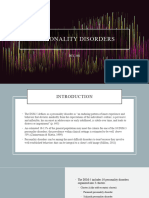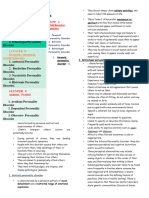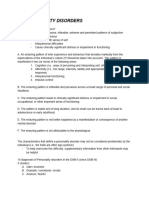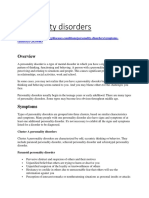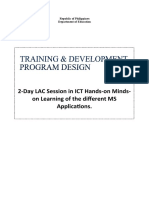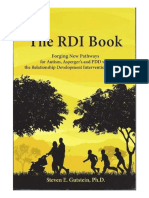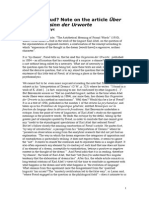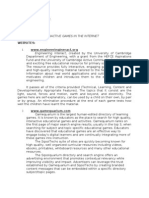Personality Disorders
Lecture Notes
Introducing personality disorders
What is a personality disorder? – an enduring, inflexible, stable pattern of inner
experience and behavior which is different from the expectations of the person’s culture
o Cluster A – odd or eccentric disorders. Individuals typically feel uncomfortable or
suspicious of others or restrict their relationships
o Cluster B – dramatic, emotional, or erratic disorders. Individuals show a wide
diversity of patterns of social and emotional interactions with others
o Cluster C – anxious or fearful disorders. Individuals experience feelings such as
social inhibition, inadequacy, the need to be taken care of, perfectionism, etc.
Comorbidity of personality disorders – individuals with a personality disorder often meet
criteria for other disorders, especially anxiety, mood, and substance use disorders
o They may also meet criteria for other personality disorders, as well
Personality disorders and normal personality traits – personality characteristics reflected
in personality disorders can be seen as an extreme version of normal personality
characteristics. Thus, there can be both healthy and maladaptive personality styles.
The characteristics of a healthy self – according to DSM-5, the healthy self is defined in
terms of a “Self and Interpersonal Functioning Continuum.” Aspects of this continuum
include identity, self-direction, and the ability to have positive interpersonal relationships.
Normal personality traits – according to the Five Factor Model (FFM), a person’s
personality is thought to comprise of five dimensions: extraversion, neuroticism,
openness, agreeableness, and conscientiousness
o People show varying degrees of each these traits, depending on genetics
Evolution and different personality characteristics – each personality characteristic may
have evolutionary costs and benefits given certain environmental conditions
Personality and personality disorders – personality disorders can be understood as
maladaptive variants of the five factor model
o One characteristic of such disorders is the stable occurrence of the personality
structure. The expression of the illness changes only slightly across the lifespan.
Categories and dimensions – some have suggested that there would be advantages to
considering personality disorders along a spectrum
1
� Environmental and genetic studies of personality disorders – studies have shown that
abuse and neglect are related to the later development of personality disorders
o Heritability estimates range from 40-60%, suggesting the involvement of both
genetic and environmental factors in the development of these disorders
Odd-eccentric personality disorders – the behavior of individuals with these disorders may seem
similar to individuals with schizophrenia except they show a greater grasp of reality
Paranoid personality disorder – characterized by a pervasive distrust and
suspiciousness of others
o The interpersonal style of these individuals is often quarrelsome, stubborn, and
rigid in their own beliefs
Schizoid personality disorder – characterized by a pervasive pattern of detachment from
social relationships and a restricted range of emotional expression
o They do not desire close relationships, lack friends, and seek solitary activities
Schizotypal personality disorder – characterized by odd beliefs and behaviors, including
excessive social anxiety and showing unusual ideas such as magical thinking
o Individuals may also display cognitive distortions and inappropriate affect
Dramatic emotional personality disorders – characterized by dramatic and impulsive behaviors
Antisocial personality disorder and psychopathy – these two disorders have different
formal definitions, even though the media tend to use the words interchangeably
o Antisocial personality disorder – criteria include acts since the age of 15 such as
repeated participation in illegal acts, deceitfulness, lack of remorse, etc.
Emphasis is placed on the breaking of societal rules, including laws.
Criteria tend to focus on observable behaviors.
o Psychopathy – individuals show emotional detachment with a lack of empathy for
the experiences of others. They also show impulsive behavior and a callousness
concerning their actions. This disorder is seen as an internal personality problem.
Although these individuals may appear well adjusted and socially
appealing, there exists severe pathology
Being cunning and manipulative while not considering the well-
being of others may be evolutionarily adaptive in some situations
Psychopathy has often been described in terms of a deficit in emotional
processing (i.e., fearlessness and externalizing vulnerability)
2
� o The brain involvement in psychopathy – the frontal lobes and temporal regions
including the hippocampus and amygdala are thought to play a role in
psychopathology
Psychopathic behaviors may result from neurodevelopmental
abnormalities
Borderline personality disorder (BPD) – characterized by instability in mood,
interpersonal relationships, and sense of self. Feelings of emptiness and boredom are
common, as well as feelings of being special or having exceptional talents
o Individuals with BPD may display an intense need for attention and closeness but
also a deep fear of rejection and abandonment
o Many people with BPD engage in self-injurious behavior to elicit feelings of being
alive. These acts are closely related to attempts to regulate one’s emotions.
o Along with genetics, environmental factors play an important role in BPD
o Brain studies of those with borderline personality disorder
Structural and functional aspects of the brain are altered in individuals
with BPD. Individuals have less volume in a number of brain areas and
respond differently to certain stimuli, such as empathetic situations
o Trust and borderline personality disorder – those with BPD are less trustful of
others and experience more distress when interacting with people
Histrionic personality disorder – characterized by a pervasive pattern of excessive
emotionality and attention seeking. Individuals may be highly dramatic, seductive, etc., in
order to draw attention to themselves.
o Afflicted individuals feel uncomfortable when they are not the center of attention
Narcissistic personality disorder – characterized by a pervasive pattern of grandiosity, a
need for admiration, a sense of privilege or entitlement, and a lack of empathy for others
o Individuals think only of their image and lose close contact with others and the
world. They need others only as people to validate their own views.
Anxious fearful personality disorders – characterized by fearful and avoidant behaviors
Avoidant personality disorder – characterized by a pervasive pattern of social inhibition,
feelings of inadequacy, and hypersensitivity to negative evaluation
o Individuals avoid many social interactions, especially those involving close
relationships with other people
3
� Dependent personality disorder – characterized by a pervasive pattern of clinging and
being submissive. Individuals have difficulty making everyday decisions without
reassurance from others.
o Afflicted individuals tend to feel anxious and helpless when alone
Obsessive-compulsive personality disorder – characterized by a pervasive pattern of
preoccupation with orderliness, perfectionism, and control of one’s environment
o The need to control is part of the individual’s self in every domain that the person
experiences; it is a way of life rather than a reaction to external processes. In this
way, it is distinguished from OCD, in which individuals attempt to control events
that take place outside of themselves.
Treatment of personality disorders – treatment is difficult because one individual with a
personality disorder may show different signs and symptoms than another, and also because
afflicted individuals find it difficult to maintain a close relationship with their therapist
Dialectical behavior therapy (DBT) – a treatment approach for BPD that is based on
problem solving and acceptance of the experience of the moment
o Therapy involves helping the client develop a stable life and skills in emotional
regulation, having the individual process previously experienced traumatic events
to resolve tensions associated with blame, and helping the individual develop a
sense of self, allowing her to live independently
Dynamic deconstructive psychotherapy (DDP) – designed to help individuals with BPD
develop a coherent sense of self. This treatment was developed for clients who find
therapy difficult as well as for those who may also have substance abuse problems.
o Treatment involves identifying the client’s difficulties and establishing goals for
working on them, developing the ability to maintain complex ideas related to
relationships with others, learning to verbalize and experience disappointments
and loss, and fostering a relationship between client and therapist
Transference-focused psychotherapy (TFP) – seeks to reduce symptoms of BPD,
especially destructive behaviors. This technique involves an exploration of how the
person views herself and how she may combine her identity with that of another.
o Emphasis is on the relationship between client and therapist
Treatments for the other personality disorders – empirically validated treatments are not
available at this time
4
�DSM future considerations of personality disorders – personality disorders may one day be
conceptualized along a continuum based on ratings of self-identity, self-direction, interpersonal
empathy, and interpersonal intimacy






